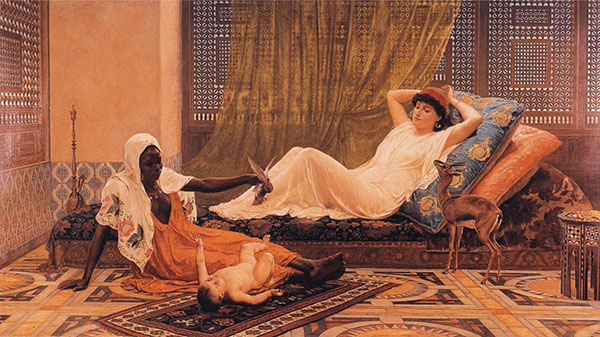For centuries historians have imagined the harems of ancient Egypt as opulent sexual paradises, however the reality was quite different.
The image of the harem as a place of private debauchery became common with the sensationalized Orientalist art of the nineteenth century. Inspired by the legendary opulence of the Turkish Sultan’s seraglio, paintings depicting women clad in diaphanous silk and lounging on lush pillows became the standard for imagining the harems of the Near East. Historians have now been able to construct a wholly different picture for the harems of ancient Egypt.
Women‘s Quarters
In ancient Egypt, as in many modern Near Eastern cultures, part of a household was usually defined as the women’s quarters. If ancient tradition was similar to modern, then only on rare occasion would grown men of the family enter the women’s quarters and never an outsider. Ancient Egyptian society was largely monogamous but women of several generations and their children could often be found be found sharing the same cramped space.
Over the last few centuries as the languages from the Ancient Near East have been translated into modern languages, harem, with all its implications has been used to describe these women’s quarters. However, these quarters were often somewhat stark in comparison to the plush imagery of the word harem.
Diplomatic Marriages
For the Pharaohs of ancient Egypt marriage was more of a political than social arrangement. In fact throughout the history of Egypt the political aspect of royal marriage would outweigh any other.
The early dynastic period king Narmer, the first ruler to unite Egypt, was from the south and he married a bride from the north in an attempt to consolidate his conquests. Their son, king Horus-Aha, then had an undisputed claim to the throne of a united Egypt. A thousand years later the pharaohs of the New Kingdom had expanded the reach of political marriages to unite the royal houses of different kingdoms across the Near East.
By the height of the 18th dynasty’s power, Pharaoh Tuthmose IV married the daughter of the king of Mitanni. Prior to this marriage Egypt and Mitanni had been bitter rivals as each sought to gain control of western Syria and Canaan. After the marriage the two royal houses became trading partners and vast caravans of goods traveled between the two lands. For three generations the diplomatic marriage alliance between Egypt and Mitanni kept the Near East relatively stable. During this time Egyptian Pharaoh’s also married princesses from Babylonia, Arzawa and eventually from the Hittite kingdom of Hatti.
Together with these important princesses were dozens of lesser brides from minor kingdoms and vassal states. Tuthmose IV’s son Amenhotep III is renowned for at least six foreign brides as well as a number of Egyptian ones. Because of this reputation Amenhotep III (and also Ramses II) often forms the base for the story of the stereotyped lecherous old monarch constantly on the lookout for fresh playthings.
Amenhotep III
While some pharaohs have been known for their pursuits of the sensual pleasures, they notably relied on professional courtesans for these encounters rather than foreign princesses. Amenhotep III’s historical record is actually remarkable for the elevated status of his Great Queen, an Egyptian native, Tiye. The mention of his other wives is only in passing and on such occasions it is made clear that Tiye remained as Great Queen.
What then must Amenhotep III’s court have been like with numerous queens all in waiting on the king while one wife ruled as the pharaoh’s near equal? One of the Amarna letters tells of a quandary involving one princess who possibly went missing and other letters detail the lengthy negotiations undertaken to arrange a diplomatic marriage.
According to the archeological evidence at least a few of Amenhotep III queens had their own quarters at Amenhotep’s palace which is known today as Malkata. These ladies not only had quarters here but there is evidence that they controlled considerable wealth and employed seasoned bureaucrats to help them administer it. Tiye herself was so important that the King of Mitanni actually corresponded with her after her husband’s death.
Mer Wer
Evidence from an archeological dig in the Faiyum region of central Egypt has shed further light on the living arrangements of the royal wives during the 18th Dynasty. The city of Mer Wer (Great Canal) was apparently the sight of a royal harem since the time of Tuthmose III. While this city is not located near either of the kingdom’s two traditional capitals of Memphis and Thebes it does sit at the entrance to the fertile lands of the Faiyum.
This location was used for the duration of the 18th dynasty as one of several locations where the lesser queens of Egypt might reside. By all accounts these women would have enjoyed one of the most liberal societies of all antiquity but nevertheless royal women would lead a somewhat tedious existence. Beyond the duties of child care, much of which was handled by mid-wives, it was unseemly for royal women to participate in day to day activities.
The little evidence that exists of daily life in a royal harem suggests there was little to tell. Once a queen was assigned to a secondary location like Mer-Wer their actual duties were likely very few. The tale of a conspiracy against the king Ramses III which arose from queens in the royal harem reveals that, although out of the picture, these secondary wives still had power. It was perhaps with this recognition of potential trouble that harems removed from the royal court were eventually used to isolate the numerous secondary queens.
Sources:
- Tyldesley, Joyce (Daughter’s of Isis, Penguin Books, London, 1994.)
Hello, Julia or someone from the stuff, I need category Ancient Egypt, I have a lot of interesting articles.








